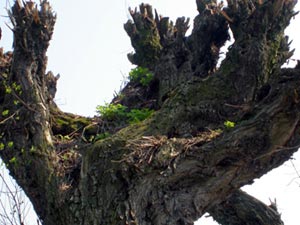 |
 |

|
Willows and Fences |
|
|
The special character of the landscape along the Vistula is significantly formed by pollarded willows and wattle fences made from willow rods. The farmers of the Vistula valley used white willow (salix alba) and basket willow or osier (salix viminalis). The relation of the Niedrunger to their willows is a very good example for the way they adapted themselfs to their environment and the available natural resources. |
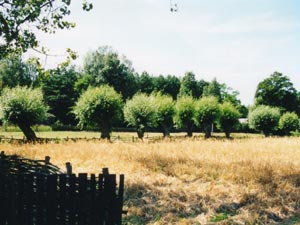
Wattle fences and willow trees - Photo by: Jutta Dennerlein, 2001 |
|
Willows need a lot of water. Therefore they are often found in river valleys and other wet areas. They are the perfect plants for flooding areas since they don't mind the extreme changes between flooding and drought. Only willows, black poplar (populus nigra) and European alder (alnus glutinosa) can survive these conditions. The Niedrunger made good use of the willow's tremendous need for water. The many willows they had planted evaporated within short time the superfluous water that was left by the floods. |
|
|
In early spring the pollen of the willows were the first food for the bees that were kept by the farmers. From the early days the bark of the willows was known to contain an antipyretic and painkilling drug. The active substance acetylsalicylic acid is produced synthetically for more than 100 years now (better known under the trademark Aspirin). |
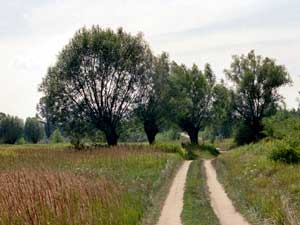
Old pollarded willows - Photo by: Jutta Dennerlein, 2005 |
|
Willows and poplars were planted between the houses and the Vistula. During the spring floods the huge trees protected the wooden houses against the drifting ice floes of the Vistula. |
|
|
Adolf Eichler writes [1]: "A special characteristic of the German Vistula villages were the 'Hocke', wattle fences made from willow shoots. They surround each farm building and divide the farm area in multiple parts. Rows of willows are planted along these wattle fences." The rows of willows consisted of pollarded willows. |
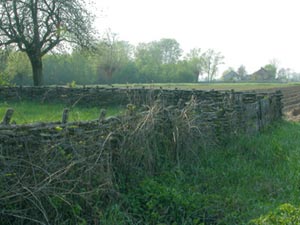
Old wattle fence - Photo by: Jutta Dennerlein, 2006 |
|
Pollarded willows develop from willows which had their trunks cut in a convenient height and which had their shoots regularly clipped off. After a short time the trunk thickens where the shoots were clipped and the characteristic head like form develops. |
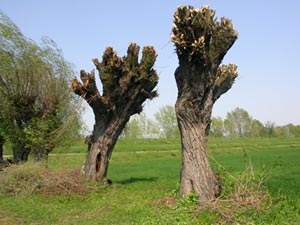
Pollarded willows - Photo by: Jutta Dennerlein, 2006 |
|
These 'heads' sometimes create a small world in itself. Giving a home to specialized plants and small animals. |
Microcosm willow head - Photo by: Jutta Dennerlein, 2006 |
|
The clipped rods were used for wattle work like household articles, furniture, fences and sometimes also for house building to fill the timber-frames. Depending on the planned use the willow rods were harvested in younger or older state. |
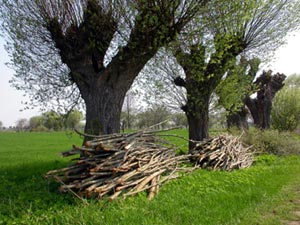
Willow rods - Photo by: Jutta Dennerlein, 2006 |
|
If a pollarded willow is not cut back anymore, it develops big branches. The weight and the then uneven static of the tree often splits the trunk of the willow and the tree dies. |
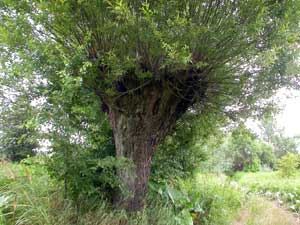
Old pollarded willow - Photo by: Jutta Dennerlein, 2005 |
|
A wattle fence is created by driving poles made from thicker willow branches in regular distance into the ground. Willow shoots are wound alternating, overlapping and very close together round the poles. These very tight fences kept even smaller farm animals from visiting the neighbours grounds. Used as field seperators they served as windbreak. |
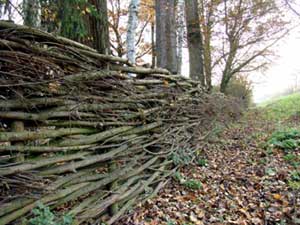
Willow wattle fence - Photo by: Marcin Zamorski, 2004 |
|
Some people say the willow rods used for building these fences should be steamed for fifteen minutes to make them more flexible and more durable. But people who had helped to build these fences when they were young told me, that the Niedrunger simply used the fresh shoots in spring without steaming. Willows do have extreme regenerative powers. So it happened that the fresh poles of the wattle fences grew roots in the wet ground and soon started to sprout. These living poles resisted rotting and became stronger and more robust every year. No high-tech product found in any garden center can offer similar qualities. |
|
[1] Adolf Eichler - Das Deutschtum in Kongresspolen, Stuttgart, 1921, page 76 |
|
